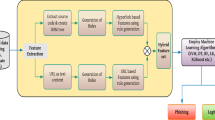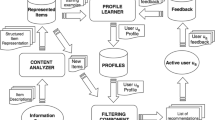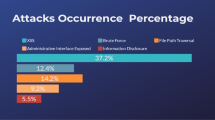Abstract
Web caching is a significantly important strategy for improving Web performance. In this paper, we design SmartCache, a router-based system of Web page load time reduction in home broadband access networks, which is composed of cache, SVM trainer and classifier, and browser extension. More specifically, the browser interacts with users to collect their experience satisfaction and prepare training dataset for SVM trainer. With the desired features extracted from training dataset, the SVM classifier predicts the classes of the Web objects. Then, integrated with LFU, the cache makes a cache replacement based on SVM-LFU policy. Finally, by implementing SmartCache on a Netgear router and Chrome browsers, we evaluate our SVM-LFU algorithm in terms of Web page load time, SVM accuracy, and cache performance, and the experimental results illustrate that SmartCache can greatly improve Web performance in Web page load time.









Similar content being viewed by others
References
Sundaresan, S., & Feamster, N. (2013). Measuring and mitigating web performance bottlenecks in broadband access networks. In Proceedings of Internet Measurement Conference, Barcelona, Spain.
Brutlag, J. (2009). Speed matters for google web search http://services.google.com/fh/files/blogs/google_delayexp
Lohr, S. (2012). For impatient web users, an eye blink is just too long to wait, 2012 http://www.nytimes.com/2012/03/01/technology/impatient-web-users-flee-slow-loading-sites.html?pagewanted=all&_r=0.
Koskela, T., Heikkonen, J., & Kaski, K. (2003). Web cache optimization with nonlinear model using object features. Computer Networks, 43, 805–817.
Cherkasova, L. (1998). Improving www proxies performance with greedy-dual-size-frequency caching policy. In Hp Technical Report. Palo Alto.
Kumar, P. N. V., & Reddy, V. R. (2014). Web proxy cache replacement policies using decision tree (DT) machine learning technique for enhanced performance of web proxy. International Journal on Recent and Innovation Trends in Computing and Communication, 2(2), 302–309.
Abrams, M., Standridge, C. R., Abdulla, G., Fox, E. A., & Williams, S. (1996). Removal policies in network caches for World-Wide Web documents. In Proceedings on Applications, Technologies, Architectures, and Protocols for Computer Communications (pp. 293–305). Palo Alto: CA.
Cao, P., & Irani, S. (1997) Cost-aware WWW proxy caching algorithms. In Proceedings of the 1997 Usenix Symposium on Internet Technology and Systems. Monterey, CA.
Wooster, R. P., & Abrams, M. (1997). Proxy caching that estimates page load delays. Computer Networks and Isdn Systems, 29(8–13), 977–986.
Rizzo, L., & Vicisano, L. (2000). Replacement policies for a proxy cache. IEEE/ACM Transactions on Networking, 8(2), 158–170.
Ali, W., & Shamsuddin, S. (2009). Intelligent client-side web caching scheme based on least recently used algorithm and neuro-fuzzy system. In W. Yu, H. He, & N. Zhang (Eds.), Advances in Neural Networks-ISNN 2009 (pp. 70–79). Berlin: Springer.
Ali, W., & Shamsuddin, S. M. (2011). Neuro-fuzzy system in partitioned client-side Web cache. Expert Systems with Applications, 38, 14715–14725.
Cobb, J., & ElAarag, H. (2008). Web proxy cache replacement scheme based on back-propagation neural network. Journal of Systems and Software, 81, 1539–1558.
Romano, S., & ElAarag, H. (2011). A neural network proxy cache replacement strategy and its implementation in the Squid proxy server. Neural Computing and Applications, 20, 59–78.
Ali, W., Shamsuddin, S. M., & Ismail, A. S. (2012). Intelligent web proxy caching approaches based on machine learning techniques. Decision Support Systems, 3, 565–579.
Negrao, A. P., Roque, C., Ferreira, P., & Veiga, L. (2015). An adaptive semantics-aware replacement algorithm for web caching. Journal of Internet Services and Applications, 6, 1–14.
Ali, W., Shamsuddin, S. M., & Ismail, A. S. (2012). Intelligent naive Bayes-based approaches for Web proxy caching. Knowledge-Based Systems, 31, 162–175.
Kaya, C. C., Zhang, G., Tan, Y., & Mookerjee, V. S. (2009). An admission-control technique for delay reduction in proxy caching. Decision Support Systems, 46, 594–603.
Kumar, C., & Norris, J. B. (2008). A new approach for a proxy-level web caching mechanism. Decision Support Systems, 46, 52–60.
Kumar, C. (2009). Performance evaluation for implementations of a network of proxy caches. Decision Support Systems, 46, 492–500.
Chen, H. T. (2008). Pre-Fetching and Re-Fetching in Web Caching Systems: Algorithms and Simulation. Peterborough, Ontario, Canada: Trent University.
Kin-Yeung, W. (2006). Web cache replacement policies: A pragmatic approach. IEEE Network, 20, 28–34.
Vakali, A. (2002). Evolutionary techniques for Web caching. Distributed and Parallel Databases, 11, 93–116.
Chen, R.-C., & Hsieh, C.-H. (2006). Web page classification based on a support vector machine using a weighted vote schema. Expert Systems with Applications, 31, 427–435.
Wikipedia (2014). Cache pollution http://en.wikipedia.org/wiki/Cachepollution
Conti, M., Gasti, P., & Teoli, M. (2013). A lightweight mechanism for detection of cache pollution attacks in Named Data Networking. Computer Networks, 57, 3178–3191.
Deng, L., Gao, Y., Chen, Y., & Kuzmanovic, A. (2008). Pollution attacks and defenses for internet caching systems. Computer Networks, 52(5), 935–956.
Ali, W., Shamsuddin, S. M., & Ismail, A. S. (2011). A survey of web caching and prefetching. International Journal of Advances in Soft Computing and its Applications, 3, 1–26.
Farhan, (2007). Intelligent Web Caching Architecture, Faculty of Computer Science and Information System. Johor, Malaysia: UTM University.
Sulaiman, S., Shamsuddin, S. M., Forkan, F., & Abraham, A. (2008) Intelligent Web caching using neurocomputing and particle swarmoptimization algorithm, modeling and simulation, 2008. In AICMS 08 Second Asia International Conference on, 2008 (pp. 642–647).
Baskaran, K. R., & Kalaiarasan, C. (2014). Pre-eminence of combined Web pre-fetching and Web caching based on machine learning technique. Arabian Journal for Science and Engineering, 39, 7895–7906.
Aptimize (2010). Website performance benchmarks, 2010. http://www.aptimize.com/Upload/docs/2010-Website-Performance-Benchmarks.
WebPagetest. http://www.webpagetest.org/.
Hablinger, G., & Hartleb, F. (2011). Content delivery and caching from a network providers perspective. Computer Networks, 55(18), 3991–4006.
Cloud, C. (2012). Some interesting bits about latency. https://www.citycloud.com/city-cloud/some-interesting-bits-about-latency/.
Qi, X., Keally, M., Zhou, G., Li, Y., & Ren, Z. (2013). AdaSense: Adapting Sampling Rates for Activity Recognition in Body Sensor Networks. In Proceedings of the 19th IEEE Real-Time and Embedded Technology and Applications Symposium (pp. 163–172). Philadelphia, PA.
Qi, X., Zhou, G., Li, Y., & Peng, G. (2012). Radio Sense: Exploiting wireless communication patterns for body sensor network activity recognition. In Proceedings of the 33rd IEEE Real-Time Systems Symposium (pp. 95–104). San Juan, Puerto Rico.
Hsu, C. W., Chang, C. C., & Lin, C. J. (2003). A practical guide to spport vector classification. http://www.csie.ntu.edu.tw/~cjlin/papers/guide/guide.pdf.
IP Tracker. http://www.ip-tracker.org/domain-to-location.php.
Afrodigit.com, Top 100 most visited websites in the world 2014. http://afrodigit.com/visited-websites-world/.
Marshall, A. D., & Hurley, S. (1996). The design, development and evaluation of hypermedia courseware for the World Wide Web. Multimedia Tools and Applications, 3, 5–31.
Huber, J., & Ding, Y. (2013). Adapting web pages using graph partitioning algorithms for user-centric multi-device web browsing. Multimedia Tools and Applications, 62, 209–231.
Acknowledgments
The work is supported in part by the National Natural Science Foundation of China (Grant nos. 61402380 and 61528206), the Natural Science Foundation of CQ CSTC (Grant no. cstc2015jcyjA40044), U.S. National Science Foundation (Grant nos. CNS-1253506 (CAREER) and CNS-1250180), the Fundamental Research Funds for the Central Universities (Grant no. XDJK2015B030), and the Opening Project of State Key Laboratory for Novel Software Technology (Grant no. KFKT2016B13).
Author information
Authors and Affiliations
Corresponding author
Rights and permissions
About this article
Cite this article
Li, Y., Zhou, G. & Nie, B. Improving Web Performance in Home Broadband Access Networks. Wireless Pers Commun 92, 925–940 (2017). https://doi.org/10.1007/s11277-016-3585-1
Published:
Issue Date:
DOI: https://doi.org/10.1007/s11277-016-3585-1




